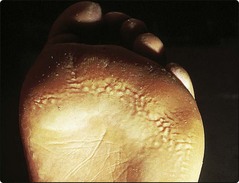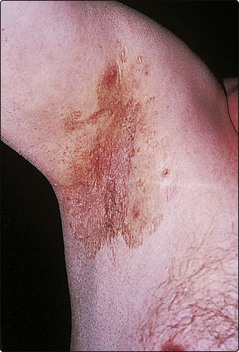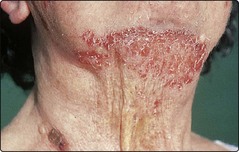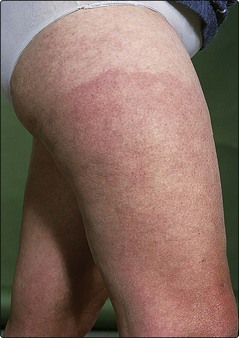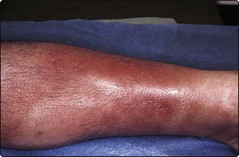Other bacterial infections
Diseases due to commensal overgrowth
Sometimes, ‘normal’ commensals can result in disease. Among the most common are the following:
 Pitted keratolysis. Overgrowth of resident micro-organisms, that digest keratin; occurs with occluding footwear and sweaty feet (Fig. 1). Malodorous pitted erosions and punched out, discoloured areas result. Better hygiene, topical neomycin or soaks with 0.01% aqueous potassium permanganate or 3% aqueous formaldehyde usually help.
Pitted keratolysis. Overgrowth of resident micro-organisms, that digest keratin; occurs with occluding footwear and sweaty feet (Fig. 1). Malodorous pitted erosions and punched out, discoloured areas result. Better hygiene, topical neomycin or soaks with 0.01% aqueous potassium permanganate or 3% aqueous formaldehyde usually help.
 Erythrasma. A dry, reddish–brown, slightly scaly and usually asymptomatic eruption that affects the body folds (Fig. 2). It fluoresces coral pink with Wood’s light, owing to the production of porphyrins by the corynebacteria. Imidazole creams, topical fusidic acid or oral erythromycin are effective.
Erythrasma. A dry, reddish–brown, slightly scaly and usually asymptomatic eruption that affects the body folds (Fig. 2). It fluoresces coral pink with Wood’s light, owing to the production of porphyrins by the corynebacteria. Imidazole creams, topical fusidic acid or oral erythromycin are effective.
 Trichomycosis axillaris. Overgrowths of corynebacteria form yellow concretions on axillary hair. Topical antimicrobials usually effect a cure.
Trichomycosis axillaris. Overgrowths of corynebacteria form yellow concretions on axillary hair. Topical antimicrobials usually effect a cure.
Mycobacterial infections
Mycobacterium tuberculosis and M. leprae (p. 60) are the most important mycobacteria in human disease, although other species can cause infections. In western countries, tuberculosis (TB) has recently shown resurgence, related to immigration and co-infection with HIV. In the developing world, 50% of HIV-infected individuals also have TB. TB can produce a number of cutaneous manifestations (Table 1).
Lupus vulgaris
Clinical presentation
Lupus vulgaris follows primary inoculation and develops in individuals with some immunity. It begins as painless reddish–brown nodules that slowly enlarge to form a plaque (Fig. 3), leaving scarring and sometimes destruction of deeper tissues such as cartilage. Presentation in the elderly is often due to reactivation of inadequately treated pre-existing disease.
Differential diagnosis and complications
Squamous cell carcinoma may develop in longstanding scarred lesions. The presence of M. tuberculosis somewhere in the body can induce cutaneous reactions called ‘tuberculides’. Erythema nodosum (p. 83) is the best known example. Another is erythema induratum, which occurs as painful ulcerating nodules on the lower legs of women and is thought to be a hypersensitivity response to TB.
Warty tuberculosis
A warty reddish or brown plaque, frequently on the hands, knees or buttock, results from inoculation of TB bacilli into the skin of someone with immunity from previous infection. It is rare in western countries, but is a common form of cutaneous TB in the developing world.
Spirochaetal infections
Spirochaetes are thin, spiral and motile organisms. Syphilis (p. 120), due to Treponema pallidum, is the best known spirochaetal disease, but other spirochaetes, e.g. Borrelia burgdorferi, can be pathogenic.
Non-venereal treponemal infections
 Yaws occurs in central Africa, central America and southeast Asia. In children, the treponeme enters the skin through an abrasion and, after a few weeks, results in an ulcerated papilloma that heals with scarring. Secondary lesions follow and, in the late stage, bone deformities develop.
Yaws occurs in central Africa, central America and southeast Asia. In children, the treponeme enters the skin through an abrasion and, after a few weeks, results in an ulcerated papilloma that heals with scarring. Secondary lesions follow and, in the late stage, bone deformities develop.
 Bejel (endemic syphilis), found in rural Middle Eastern tribes living in unhygienic conditions, is similar to yaws but starts around the mouth. It is transmitted by skin contact.
Bejel (endemic syphilis), found in rural Middle Eastern tribes living in unhygienic conditions, is similar to yaws but starts around the mouth. It is transmitted by skin contact.
 Pinta is confined to central and south America. It results in hyperkeratoses over extensor aspects of joints with both hypo- and hyperpigmentation.
Pinta is confined to central and south America. It results in hyperkeratoses over extensor aspects of joints with both hypo- and hyperpigmentation.
Lyme disease
Lyme disease is a cutaneous and systemic infection caused by the spirochaete Borrelia burgdorferi and spread by tick bite. Most cases have been reported in the USA and Europe. At the site of the tick bite, usually a limb, a slowly expanding erythematous ring (erythema chronicum migrans) develops (Fig. 4). Arthritis and neurological and cardiac disease may follow. A response to high-dose amoxicillin or doxycycline is usual.
Further bacterial infections
Cellulitis
Cellulitis is an infection of the subcutaneous tissues. It is often due to streptococci, but is deeper and more extensive than erysipelas. The cardinal features are swelling, redness and local pain with systemic upset and fever. The leg is often affected (Fig. 5). The organism may gain entry through fissures between the toes or via a leg ulcer. Lymphangitis is common, and lymphatic damage may result. Hospital admission is usually indicated, particularly if the leg is involved. Antistreptococcal antibiotics are given for straightforward cases. However, a broad-spectrum antibiotic is prescribed for cellulitis complicating a leg ulcer, because a selection of organisms may be responsible. Blood cultures and ulcer swabs may give some guidance.
Other bacterial infections
 Overgrowth of commensal organisms can result in minor skin ‘disease’.
Overgrowth of commensal organisms can result in minor skin ‘disease’.
 Cutaneous mycobacterial infection is mainly due to M. tuberculosis, but occasionally ‘atypical’ mycobacteria such as M. marinum cause disease.
Cutaneous mycobacterial infection is mainly due to M. tuberculosis, but occasionally ‘atypical’ mycobacteria such as M. marinum cause disease.
 Non-venereal treponematoses, e.g. yaws, are still important diseases of rural people living in poor conditions in the developing world.
Non-venereal treponematoses, e.g. yaws, are still important diseases of rural people living in poor conditions in the developing world.
 Lyme disease is a tick-transmitted infection with Borrelia burgdorferi; the skin signs are often associated with arthritis or neurological disease.
Lyme disease is a tick-transmitted infection with Borrelia burgdorferi; the skin signs are often associated with arthritis or neurological disease.
 Cellulitis often affects the leg and is frequently caused by streptococci, although other organisms may be involved.
Cellulitis often affects the leg and is frequently caused by streptococci, although other organisms may be involved.

